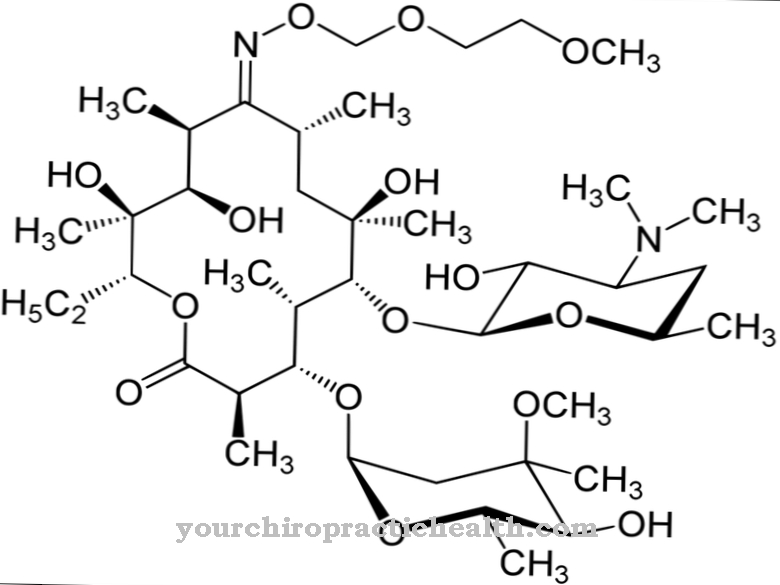Sulfonamidesare synthetic chemical antibiotics that prevent bacteria from multiplying. Today, due to their rather weak mode of action and many side effects, they are rarely used in humans. Combination preparations of sulfonamides with diaminopyrimidines are usually used to prevent resistance.
What are sulfonamides?

Sulphonamides are used as antibiotics because of their antimicrobial effect. Today they have been largely replaced by penicillins, which are more effective. Nevertheless, they are still often used for uncomplicated urinary tract diseases. They are still used particularly frequently in veterinary medicine.
Sulphonamides have the characteristic atomic group SO2NHR. With the help of this group of atoms, they develop their effect against bacteria. Of the large number of sulfonamides, only a few are still used in humans today. These include the drugs sulfamethoxazole, sulfamerazine, silver sulfadiazine or sulfadiazine.
The effectiveness of sulfanilamide against bacteria was discovered by the pathologist Gerhard Domagk in 1935. Sulfanilamide came onto the market as an antibiotic under the brand name Prontosil®. However, Prontosil only worked in vivo (in the organism) because it could only be converted into its effective form in the organism.
The first sulfonamides were replaced by the more effective penicillins as early as World War II. However, they have not been completely displaced and are still used today for certain infections.
Pharmacological effect
The effectiveness of sulfonamides is based on the disruption of folic acid formation. They occupy important active centers in the corresponding enzymes that are responsible for folic acid formation. The folic acid in turn ensures the synthesis of nucleotides. This reaction takes place in all organisms. The nucleotides are necessary for the construction of the nucleic acids.
In contrast to eukaryotic cells, bacteria produce folic acid as part of their metabolism. Eukaryotic organisms, including humans, have to take in folic acid through food. This explains the specific toxic effects of sulfonamides against bacteria.
However, there are also bacteria that do not produce folic acid. These bacterial strains are resistant to sulfonamides. However, the sulfonamides alone do not kill the bacteria. However, by inhibiting the formation of nucleic acids, they prevent the formation of new bacteria through cell division. The organism's immune system now destroys the bacteria present. This shortens the duration of the infection.
Medical application & use
The sulfonamides act against different bacterial strains, such as the intestinal bacteria Pseudomonas, Escherichia coli, Shigella or Salmonella. Furthermore, they show an activity against streptococci, staphylococci, Pneumocystis jirovecii, Neisseria, Toxoplasma gondii, Plasmodia or Neospora caninum.
The drug cotrimoxazole is used to treat uncomplicated urinary tract infections. Cotrimoxazole is a combination of sulfamethoxazole and trimethoprim. The drug is used as a combination preparation to prevent resistance to sulfonamides. Both the sulfonamides and trimethoprim block the formation of folic acid. However, they intervene at different points in the same metabolic pathway. The combination of the two active ingredients also creates a synergistic, bacteriocidal effect, i.e. the bacteria are even killed.
However, sulfamethoxazole is used alone to treat Pneumocystis jirovecii. It is also used for other respiratory infections and gastrointestinal infections. Silver sulfadiazine is used for the antibiotic treatment of wounds and burns. It is applied on the spot.
Sulfadiazine, in turn, is administered orally for Plasmodia, Toxoplasma gondii or Pneumocystis jiroveci. The drug sulfamerazine is used for respiratory diseases, diseases of the ear, nose and throat area and urinary tract infections. Sulfamerazine is mostly used here in combination with trimethoprim. It is administered in the form of tablets or by infusion.
While sulfonamides are rarely used in humans, they are considered common antibiotics in veterinary medicine. There they are often used against gastrointestinal infections, respiratory infections and urinary tract infections. In the poultry sector, they have long been used to control coccidia.
Risks & side effects
As already mentioned, sulfonamides are rarely used in humans today. In addition to the higher effectiveness of penicillins, one reason is the occurrence of side effects. When they are used, skin rashes, nausea, vomiting, loss of appetite, diarrhea, depression or even psychosis can occur.
Sulfonamides are dangerous to use during pregnancy. The breakdown of bilirubin in the fetus is disturbed, which can lead to dangerous hyperbilirubinemia in the newborn. Sulfonamides often cause an allergy on the skin. In combination with sunlight, a phototoxic reaction can be triggered. The skin reacts with itching, reddening, flaking and drying out.
Furthermore, changes in the blood count can occur. Hereditary methaemoglobinemia can cause severe haemolytic crises. A side effect is also the lowering of the aqueous humor pressure in the eye. That is why today glaucoma is often treated with eye drops that contain modified sulfonamides.
Sulphonamides must not be given together with some medications because they cause undesirable interactions. For example, if sulfonamides are used at the same time as local anesthetics such as procaine or tetracaine, their effect is canceled. There are also undesirable interactions with urotropin, which is used as a food preservative. There are also unwanted interactions with phenylbutazone, an anti-inflammatory drug. The simultaneous use of sulfonamides with Cyclosporin A threatens kidney damage.
There are clear contraindications for intolerance to sulfonamides, kidney diseases and the so-called long QT syndrome. Long QT syndrome is a heart condition caused by ion channel disorders. It is characterized by cardiac arrhythmias that can lead to ventricular fibrillation. Antibiotics like sulfonamides can cause or worsen the condition.



























